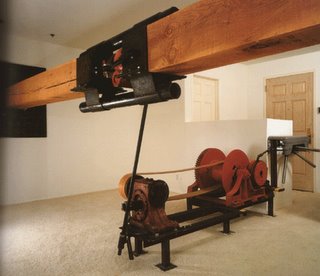
Samson," by Chris Burden, turnstile, winch, worm gear, leather strap, timbers, jack, steel and hardware installation, variable dimensions, 1985
Curated by Josh Baer
In this exhibition of early work by Chris Burden, Zwirner & Wirth will present the Deluxe Photo Book 1971- 73, accompanied by six “Relics” from performances staged between 1972 and 1980. The centerpiece of the exhibition is one of Burden’s most important post-performance sculptures, the gallery-destroying apparatus Samson from 1985.
The mythology of Chris Burden is well-known in art world circles. Chris Burden and his work emerged in the early 1970s in Los Angeles amidst a growing movement of “alternative” art forms and groups including earth, body, video, performance and conceptual art. What these groups had in common was an interest in making art that addressed political, social and environmental issues while operating outside of the established museum/gallery nexus. Burden’s early work was unavoidably steeped in Minimalism, however by 1971, with the piece Five Day Locker Piece, it became clear that Burden was forging a new path towards extreme performance.
The Deluxe Photo Book 1971 -1973, is a hand-painted binder that contains all of the photo-documentation and explanatory texts pertaining to the first three years of Burden’s performances. Throughout this period, Burden produced succinct, quasi-scientific descriptions accompanied by photographs from each performance as record of the event. The records of the performances are similar to the events that took place in that they are self-contained, self-explanatory, and reflect the crispness of Burden’s original gesture. The performances were in essence empirical investigations in to the “what ifs” of the world at large. Their purpose was to be accessible, immediate and public and it was critical to Burden that his “pursuit of the facts” be easily comprehensible.
If we think of Burden as a scientist/engineer rather than as a reckless stuntman, the performances demonstrate the depth of Burden’s inquiry into basic human fears such as being shot, stabbed, burned (Dreamy Nights, 1974) or starving to death (B.C. Mexico, 1973). On a more fundamental level the performances operate as commentary on social order and the government’s political and economic control over its people. The relic Back to You,1974, consists of a metal bowl of push pins. During the performance, Burden invited a volunteer to stab the pins into his body in an elevator while spectators watched on a monitor. The work is indeed gruesome, but more importantly, the act of stabbing becomes a physical transgression of established social mores which traditionally dictate that it is unlawful or immoral to self-mutilate. Here, as in many of the early performances, Burden takes back the power over his own body by willfully assigning it to someone else.
The viewer also becomes a witness, as in Dead Man in 1972, where Burden covered himself with a tarp lying in the road flanked by two flares. The flares would eventually burn out increasing the risk of the artist being run over by a car. In Trans-Fixed, 1974, the two nails that were used to crucify the artist to a Volkswagen car are preserved as a relic . The Volkswagen was chosen because it was the car of the “people” and Burden wanted his crucifixion to liberate not just himself but everyone. In experiencing this type of pain and vulnerability firsthand, Burden is able to make it more familiar and, in turn, he demystifies the horror of such acts by making them knowable, both for himself and for the audience. As a result, the collective fears that society uses to keep people in order are exposed and the idea that the human body is governed by law is rendered impotent.
Burden said that his work is the “acting out of an idea, the materialization of the idea”. The performances demonstrate this in their unencumbered actions that vehemently avoid any move towards symbolism. The post-performance works of the 1980s are studies of social power which “concern investigating and testing the origin of power both physical and bureaucratic and how this power ultimately shapes the world we exist in.” Samson, 1985, tests both the physical endurance of the art gallery and, on a conceptual level, the actual institution of housing and displaying art for the public consumption.
The artist describes Samson as simply “a museum installation consisting of a 100 ton jack connected to a gear box and a turnstile. The 100 ton jack pushes two large timbers against the bearing walls of the museum. Each visitor to the exhibition must pass through the turnstile in order to see the exhibition. Each input on the turnstile ever so slightly expands the jack, and ultimately, if enough people visit the exhibition, Samson could theoretically destroy the building. Like a glacier its powerful movement is imperceptible to the naked eye. This sculptural installation subverts the notion of the sanctity of the museum (the shed that houses art).”
In forcing the spectator to pass through the turnstile, Burden assigns them equal culpability in the destruction of the gallery space. The art lover becomes complicit in the destruction of the “temple” that holds the precious objects. This sinister joke, however, is actually embedded in a larger, multi-layered dialogue Burden has been engaged in from the very first performance, namely questioning the necessity of the art object and the role of the artist and the art viewer in contemporary society. The fact that Samson is clearly informed with the minimalist aesthetic that preoccupied Burden’s sculptural work as a student in the late 1960s, is not lost on the historian, nor is the preciousness of the velvet-lined vitrines that encase the relics. As fleeting as the performances were, the objects and documentation Burden gathered, organized and made available to us are thoughtfully preserved.
http://www.zwirnerandwirth.com/exhibitions/2004/0904Burden/press.html

0 Comments:
Post a Comment
<< Home